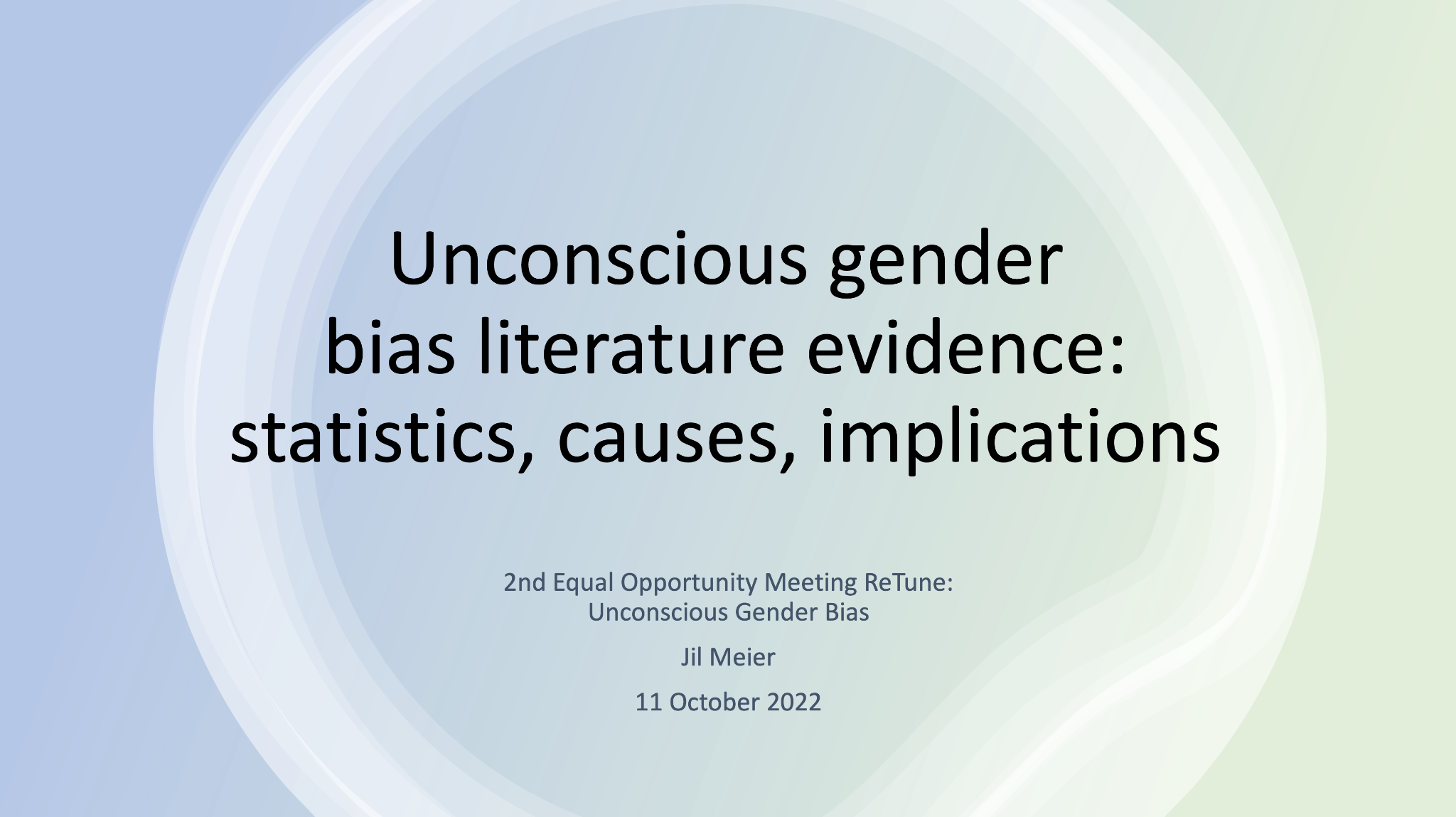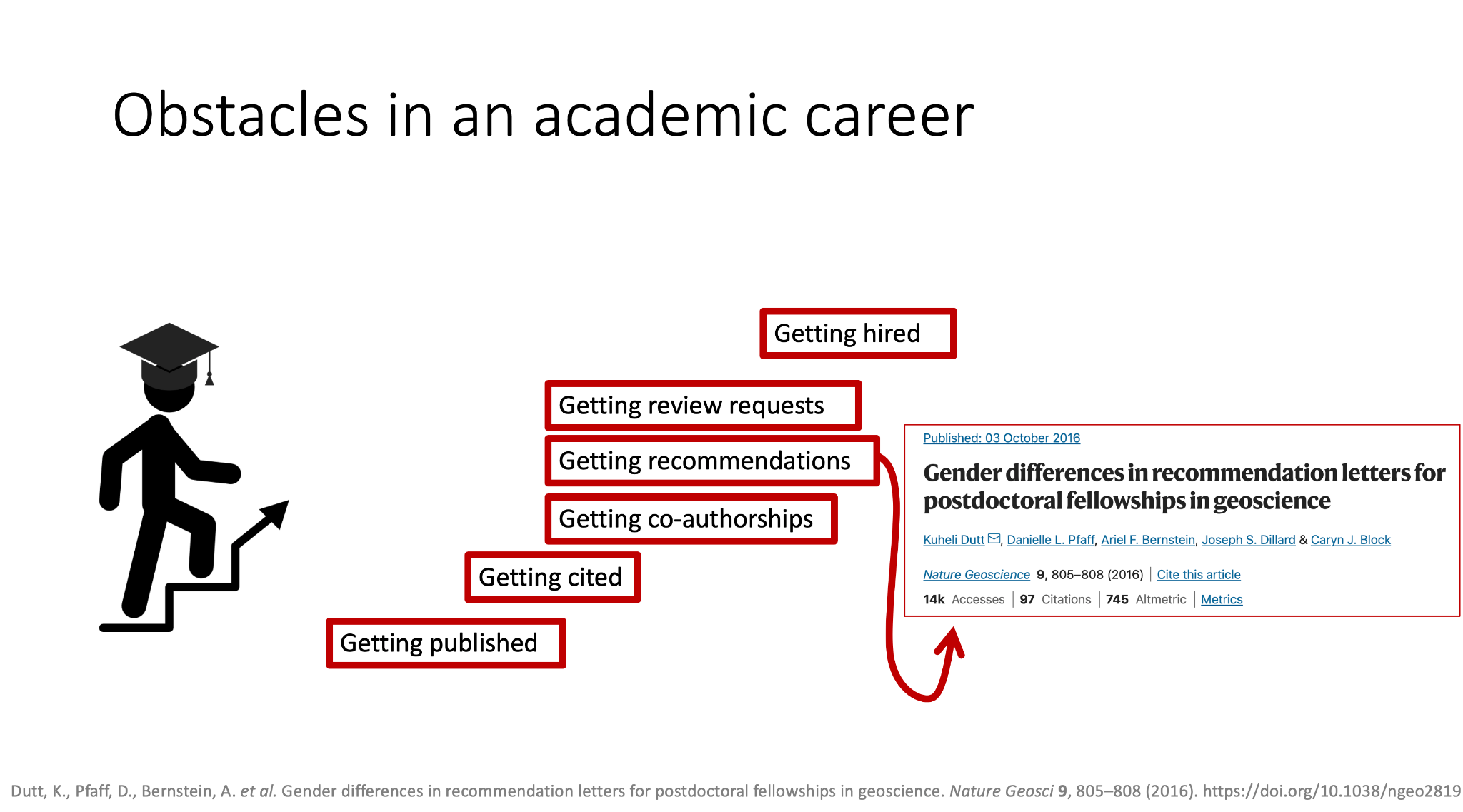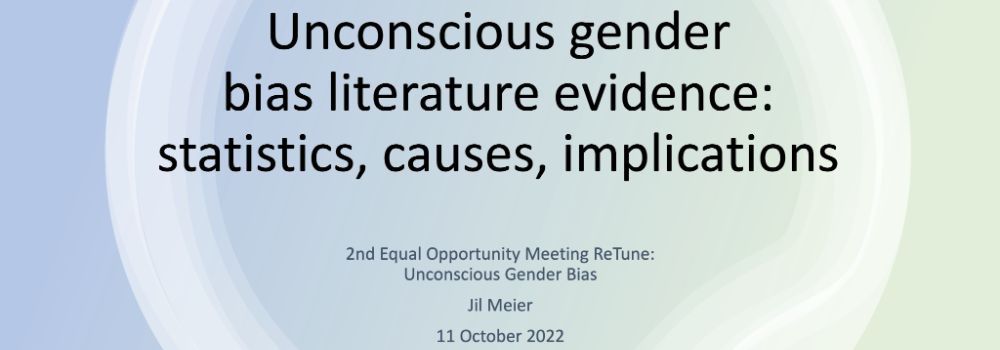Oct 14, 2022
Unconcious gender bias literature evidence: statistics, causes, implications
by Jil Meier
During the second equal opportunity community meeting of the CRC ReTune on the 11th of October, Prof. Petra Ritter and Dr. Jil Meier presented literature evidence on the topic of unconscious bias. Prof. Petra Ritter first gave a general introduction to unconscious bias explaining the concept and basic definitions for the following discussions. Then Dr. Jil Meier gave a talk titled “Unconscious gender bias literature evidence: statistics, causes, implications” during which she focused on presenting recent literature evidence from high-impact studies (mainly focusing on Nature, Science and PNAS articles). The presented evidence established that there is a gender bias in academic research staff with various recent national and international studies showing that positions higher up in the hierarchy of academic levels are still mostly filled by men. The reasons for this drop-out rate of large proportions of women from student toward professor level seem manifold. (1) One arm of recent literature suggests that the career course for women in academia can be described by a “hostile obstacle course”. Many studies were presented in detail which researched these “obstacles” from different perspectives. In summary, there is high-impact literature on the following career obstacles for women in academia: (1a) editor-reviewer-author homophily, (1b) less (self-) citations of women than men, (1c) less authorship credit is given to women working in project teams, (1d) worse recommendation letters are written for women than for men and (1e) women are less often hired than men with equal qualifications. (2) A second large source of the unequal numbers among genders in academic positions is often mentioned to be simply the generational gap which will close in a few generations by itself. (3) Another reason suggested by literature of why only about 25% of full professors are women are the gender-based differences in career preferences and fertility or lifestyle choices, which may be free or constrained choices. (4) One possibly underlying obstacle for women identified by literature is the unconscious bias. Literature evidence was presented on the related topics of stereotypic thinking, fast thinking, social identity theory and the encoding of unconscious bias potentially in the amygdala based on an MRI study combined with Implicit Association Test results. This last obstacle of unconscious bias can be changed and improved with implicit bias education and training. Afterwards, Prof. Petra Ritter summarized the literature evidence and a discussion about the issues and possible measures to be taken by the CRC with regard to this matter followed.
The slides are available upon request (jil-mona.meier@bih-charite.de and petra.ritter@bih-charite.de) and the full list of references discussed during the talk is below.




References:
https://implicit.harvard.edu/implicit/takeatest.html
https://www.youtube.com/watch?reload=9&v=g978T58gELo
https://www.youtube.com/watch?v=EOPbf3Ponew&ab_channel=LisaDierker
Grogan, K. E. (2019). How the entire scientific community can confront gender bias in the workplace. Nature Ecology & Evolution, 3(1), 3-6.
Larivière, V., Ni, C., Gingras, Y. et al. Bibliometrics: Global gender disparities in science. Nature 504, 211–213 (2013). https://doi.org/10.1038/504211a.
Dakota Murray, Kyle Siler, Vincent Larivière, Wei Mun Chan, Andrew M. Collings, Jennifer Raymond, Cassidy R. Sugimoto, Author-Reviewer Homophily in Peer Review, bioRxiv 400515; doi: https://doi.org/10.1101/400515 https://www.biorxiv.org/content/10.1101/400515v3.abstract.
Matthew Rosenblatt, Saloni Mehta, Hannah Peterson, Javid Dadashkarimi, Raimundo X. Rodriguez, Maya L. Foster, Brendan D. Adkinson, Qinghao Liang, Violet M. Kimble, Jean Ye, Marie C. McCusker, Michael C. Farruggia, Max Rolison, Margaret L. Westwater, Rongtao Jiang, Stephanie Noble, Dustin Scheinost Trends in self-citation rates in neuroscience literature, bioRxiv 2022.09.27.509533; doi: https://doi.org/10.1101/2022.09.27.509533 https://www.biorxiv.org/content/10.1101/2022.09.27.509533v1.
Markus Helmer, Manuel Schottdorf, Andreas Neef, Demian Battaglia (2017), Research: Gender bias in scholarly peer review, eLife 6:e21718. https://doi.org/10.7554/eLife.21718.
Gender in Science, Technology, Engineering, and Mathematics: Issues, Causes, Solutions, Tessa E.S. Charlesworth, Mahzarin R. Banaji, Journal of Neuroscience 11 September 2019, 39 (37) 7228-7243; DOI: 10.1523/JNEUROSCI.0475-18.2019.
Garg, N., Schiebinger, L., Jurafsky, D., & Zou, J. (2018). Word embeddings quantify 100 years of gender and ethnic stereotypes. Proceedings of the National Academy of Sciences, 115(16), E3635-E3644.
https://www.nature.com/articles/s41559-018-0747-4 about this article.
Williams, W. M., & Ceci, S. J. (2015). National hiring experiments reveal 2: 1 faculty preference for women on STEM tenure track. Proceedings of the National Academy of Sciences, 112(17), 5360-5365.
- A. Moss-Racusin, J. F. Dovidio, V. L. Brescoll, M. J. Graham, J. Handelsman, Science faculty’s subtle gender biases favor male students. Proc. Natl. Acad. Sci. U.S.A. 109, 16474–16479 (2012). https://www.pnas.org/doi/full/10.1073/pnas.1211286109.
Ross, M.B., Glennon, B.M., Murciano-Goroff, R. et al. Women are credited less in science than men. Nature 608, 135–145 (2022). https://doi.org/10.1038/s41586-022-04966-w
Jimenez, M.F., Laverty, T.M., Bombaci, S.P. et al. Underrepresented faculty play a disproportionate role in advancing diversity and inclusion. Nat Ecol Evol 3, 1030–1033 (2019). https://doi.org/10.1038/s41559-019-0911-5.
S.J. Ceci, W.M. Williams, Understanding current causes of women’s underrepresentation in science, Proceedings of the National Academy of Sciences of the United States of America, 108 (8) (2011), pp. 3157-3162.
Régner, I., Thinus-Blanc, C., Netter, A. et al. Committees with implicit biases promote fewer women when they do not believe gender bias exists. Nat Hum Behav 3, 1171–1179 (2019). https://doi.org/10.1038/s41562-019-0686-3.
S.-J. Leslie, A. Cimpian, M. Meyer, E. Freeland, Expectations of brilliance underlie gender distributions across academic disciplines. Science 347, 262–265 (2015). https://www.science.org/doi/10.1126/sciadv.abm3689.
Knutson, K.M., Mah, L., Manly, C.F. and Grafman, J. (2007), Neural correlates of automatic beliefs about gender and race. Hum. Brain Mapp., 28: 915-930. https://doi.org/10.1002/hbm.20320.
Reuben E, Sapienza P, Zingales L. How stereotypes impair women’s careers in science. Proceedings of the National Academy of Sciences of the United States of America. 2014 Mar;111(12):4403-4408. DOI: 10.1073/pnas.1314788111.
Gender in Science, Technology, Engineering, and Mathematics: Issues, Causes, Solutions, Tessa E.S. Charlesworth, Mahzarin R. Banaji, Journal of Neuroscience 11 September 2019, 39 (37) 7228-7243; DOI: 10.1523/JNEUROSCI.0475-18.2019.
I.M. Handley, E.R. Brown, C.A. Moss-Racusin, J.L. Smith, Quality of evidence revealing subtle gender biases in science is in the eye of the beholder, Proc. Natl. Acad. Sci., 112 (43) (2015), pp. 13201-13206, https://doi.org/10.1073/pnas.1510649112.
Dutt, K. Race and racism in the geosciences. Nat. Geosci. 13, 2–3 (2020). https://doi.org/10.1038/s41561-019-0519-z (Comment).
Berhe, A.A., Barnes, R.T., Hastings, M.G. et al. Scientists from historically excluded groups face a hostile obstacle course. Nat. Geosci. 15, 2–4 (2022).(Comment) https://doi.org/10.1038/s41561-021-00868-0.
Dutt, K., Pfaff, D., Bernstein, A. et al. Gender differences in recommendation letters for postdoctoral fellowships in geoscience. Nature Geosci 9, 805–808 (2016). https://doi.org/10.1038/ngeo2819.
Wapman, K.H., Zhang, S., Clauset, A. et al. Quantifying hierarchy and dynamics in US faculty hiring and retention. Nature 610, 120–127 (2022). https://doi.org/10.1038/s41586-022-05222-x.











